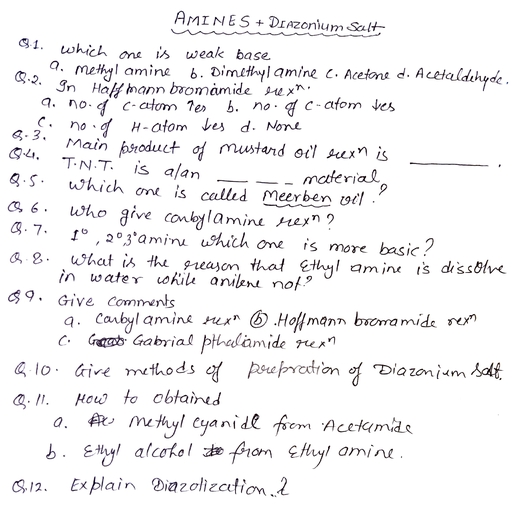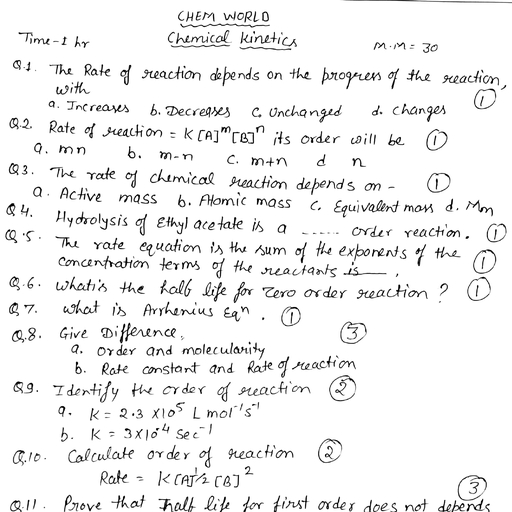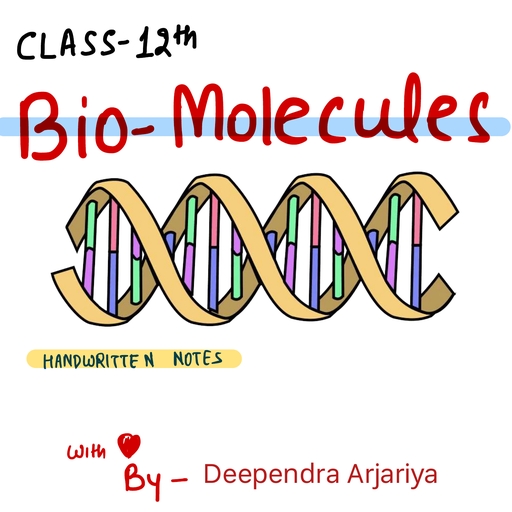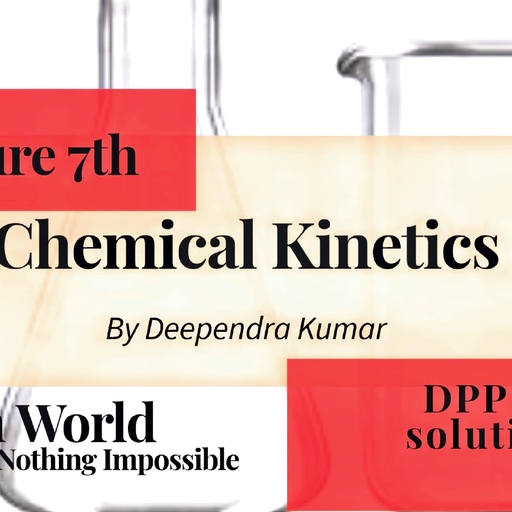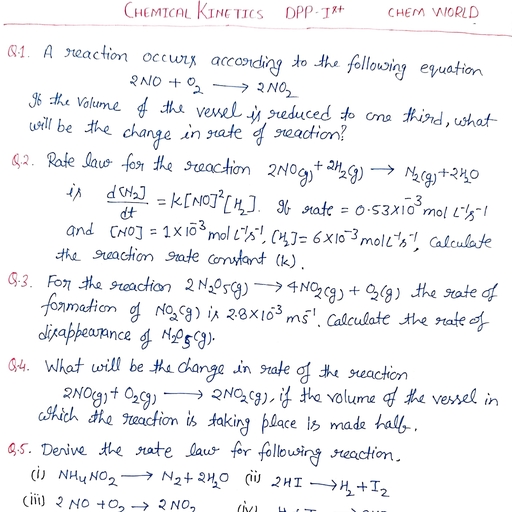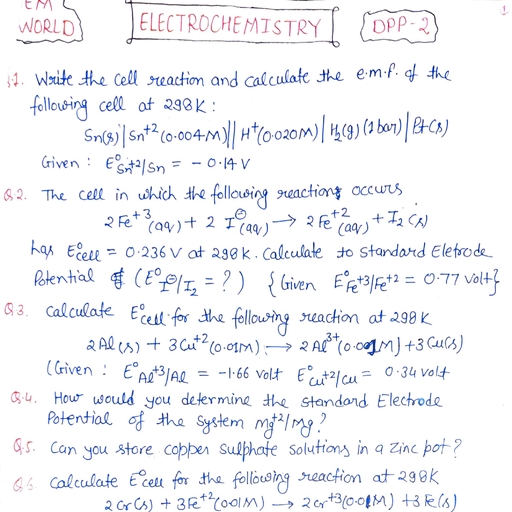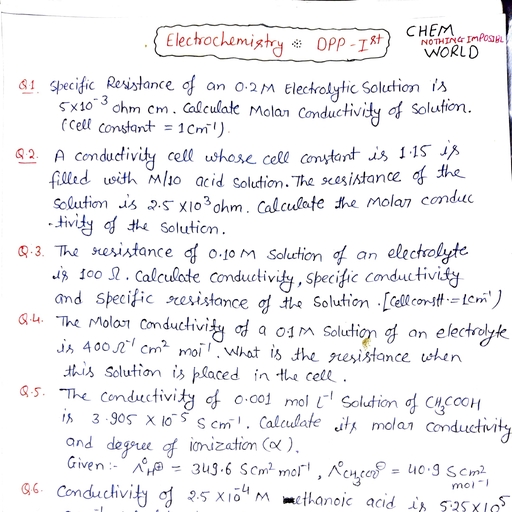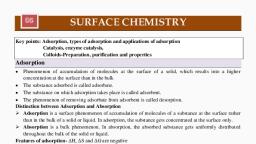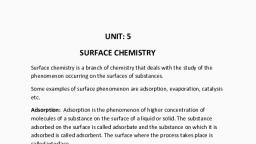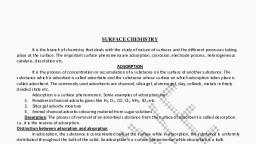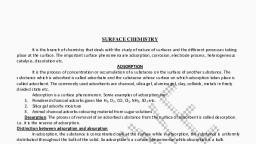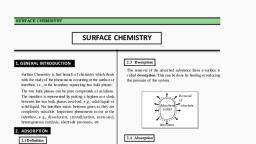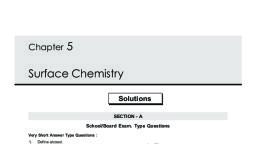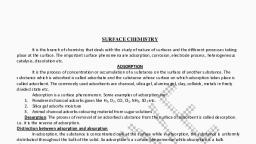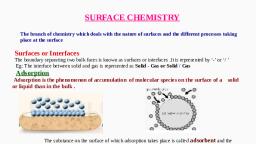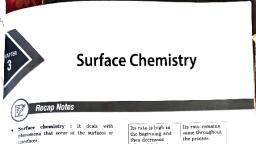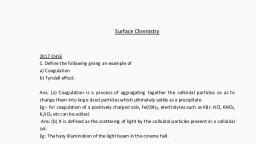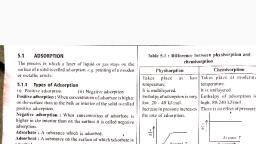Page 1 :
Surface Chemistry, Recap Notes, Surface chemistry : It deals with, phenomena that occur at the surfaces or, interfaces., Adsorption : It is the process of accumulation, of molecular species at the surface rather, than in the bulk of a solid or liquid., Adsorbate : The molecular species or, substance, which concentrates or accumulates, at the surface., Adsorbent : The material on the surface of, which the adsorption takes place., Distinction between adsorption, and absorption, Adsorption, , Absorption, , It is a surface, phenomenon, i.e.,, it occurs only at, the surface of the, adsorbent., , It is a bulk, phenomenon, i.e.,, occurs throughout, the body of the, material., , In this phenomenon,, the concentration, on the surface of, adsorbent is different, from that in the, bulk., , In this, phenomenon, the, concentration is, same throughout, the material., , Its rate is high in, the beginning and, then decreases, till equilibrium is, attained., , Its rate remains, same throughout, the process., , Desorption : The process of removing an, adsorbed substance from the surface., Sorption : The term used when both absorption, and adsorption occur simultaneously., DG, DH and DS all are – ve for adsorption., Types of adsorption : Depending on forces, which hold the adsorbate on the surface of, adsorbent, adsorption is divided into two, classes :, X, , Physical adsorption : When the, particles are held to the surface by, the physical forces like van der Waals’, forces, the adsorption is called physical, adsorption or physisorption., , X, , Chemical adsorption : When the, particles are held to the surface by the, chemical forces or by chemical bonds, the, adsorption is called chemical adsorption, or chemisorption., , Differences between physisorption and chemisorption, Property, , Physisorption, , Chemisorption, , Enthalpy, , Low enthalpy, is of the order of High enthalpy, is of the order of, 80-240 kJ mol–1, 20-40 kJ mol–1, , Reversibility, , Reversible process, , Irreversible process
Page 2 :
Effect of, temperature, , With the increase in temperature,, extent of adsorption decreases because, adsorption is an exothermic process, and kinetic energy of gas molecules, increases with temperature., , Selectivity, , Not selective in nature. Does not Highly selective in nature., depend upon the chemical properties, of adsorbent., , Nature and, state of, adsorbate, , The extent of adsorption depends The state of adsorbed molecules may, upon the ease of liquefaction of the be different from that in the bulk., gas., , Activation, energy, , No appreciable energy needed, , Pressure, , I n c r e a s e i n p r e s s u r e i n c r e a s e s Increase in pressure decreases, adsorption, adsorption, , Layers, , Multimolecular layer, , Factors affecting adsorption of gases, on solids :, X Nature of adsorbent : Greater the, strained forces on the surface, more is the, ease with which adsorption takes place, on the surface. The activated adsorbents, have high adsorbing power., X Surface area of adsorbent : Greater, X, , X, , X, , the surface area, more is the adsorption., Nature of gas being adsorbed : Easily, liquefiable gases like NH3, HCl, Cl2, SO2,, CO2, etc. (whose critical temperature is, high) are adsorbed to greater extent., Pressure : At constant temperature,, adsorption increases with increase in, pressure. The effect of pressure is large at, low temperature., Temperature : Since adsorption is, an exothermic process so according to, Le-Chatelier’s, principle, adsorption, decreases with increase in temperature., , Freundlich adsorption isotherm :, x, The plot of, vs pressure at constant, m, temperature is called Freundlich adsorption, isotherm,, where, m = mass of the adsorbent, x =, mass of the adsorbate, , Chemisorption first increases with, temperature upto a certain extent and, then decreases. A gas adsorbed at low, temperature by physical adsorption, may change into chemisorption at, high temperature., , High activation energy needed, , Mono-molecular layer, For low pressure,, For high pressure,, , x, ∝p, m, x, ∝ p0, m, , For intermediate pressures,, , log, , x, ∝ p1/ n (n > 1), m, , x, 1, = log k + log p, n, m, , Similarly, for adsorption of solutes from, x, = k . C1 / n where, C is the, m, equilibrium concentration, i.e., when, solutions,, , adsorption is complete., Plot of log, , x, vs log C is linear., m
Page 3 :
Waals’, , Properties of colloidal solutions :, X, , Colligative properties : Colloids, show colligative properties like relative, lowering of vapour pressure, elevation, of boiling point, etc. and magnitude of, colligative properties of colloids is much, less than true solutions due to larger size, of colloidal particles., , X, , Tyndall effect (Optical property) :, Scattering of light by colloidal particles due, to which the path of light beam becomes, visible., , X, , Brownian movement (Mechanical, property):, Zig-zag, movement, of, colloidal particles due to the unbalanced, bombardment by the molecules of, dispersion medium., , X, , Charge on colloidal particles : Colloidal, particles always carry an electric charge, and nature of charge (+ve or –ve) is same, on all the particles in a given colloidal, solution. The charge is due to preferential, adsorption of ions from solution., , Positively, charged sols, Hydrated metallic, oxides, e.g.,, Al2O3 ⋅ xH2O,, Fe2O3 ⋅ xH2O, metal, hydroxides, e.g.,, Fe(OH)3, Al(OH)3,, basic dye stuff, like Prussian blue,, haemoglobin (blood),, etc., , Negatively, charged sols, Metallic particles,, e.g., Cu, Ag, Au, Metal sulphides,, e.g., As2S3, CdS,, Acidic dyes like, eosin, congo red, etc, sols of gelatin,, gum, starch, etc., , Electrophoresis (Electrical property):, Movement of colloidal particles towards, one of the electrodes on passage of, electricity through colloidal solution. The, direction depends on the type of charge on, colloidal particles., X Coagulation of colloids : Precipitation of, colloidal solution by induced aggregation, of colloidal particles., – Lyophobic sols: They can be coagulated, by electrophoresis, boiling, persistent, dialysis, mixing of oppositely charged sols, and addition of electrolytes., X
Page 4 :
– Hardy–Schulze rules :, • In case of electrolytes, the ion carrying, charge opposite to that of colloidal particles, is effective in causing coagulation and, greater the valency of the ion causing, coagulation, greater is the coagulating power., • The minimum concentration of an, electrolyte in millimoles per litre required, , to cause precipitation of a sol in two hours, is called coagulating value. The smaller, the quantity needed, the higher will be, the coagulating power of an ion., – Lyophilic sols : They can be coagulated, by addition of electrolytes or addition of a, suitable solvent.
Page 5 :
Practice Time, , Surface Chemistry, , 51, , OBJECTIVE TYPE QUESTIONS, , Multiple Choice Questions (MCQs), 1. Which of the following statements is not, correct about physiosorption?, (a) It is a reversible process., (b) It requires less heat of adsorption., (c) It requires activation energy., (d) It takes place at low temperature., 2. The term activation of adsorbent is used, when, (a) adsorbing power is increased by increasing, surface area by making the surface rough, (b) adsorbing power is increased by dipping the, surface in acid to make it smooth, (c) adsorbing power is increased by dissolving, it in water, (d) adsorbing power is decreased to reduce the, extent of adsorption., 3. When a colloidal solution is viewed from the, direction at right angles of light beam, the path, of the beam is illuminated due to scattering of, light. In the figure (A) and (B) are, Microscope, , Light source, , (a), (b), (c), (d), , A, A, A, A, , -, , (A), , (B), , Colloidal solution, , Tyndall cone, B - Scattered light, Scattered light, B - Tyndall cone, Tyndall cone, B - Blind spot, Tyndall effect, B - Tyndall cone, , 4. Which of the following statements does not, show correct difference between adsorption and, absorption?, (a) In adsorption the substance is concentrated, only at the surface while in absorption it is, uniformly distributed in the bulk., (b) Adsorption is instantaneous while absorption, is a slow process., , (c) A substance can be adsorbed as well as, absorbed simultaneously and the process is, called sorption., (d) Only gases are adsorbed while solids and, liquids are absorbed., 5. Which of the following is not a method for, coagulation of lyophobic sols?, (a) By electrophoresis, (b) By mixing oppositely charged sols, (c) By adding electrolyte, (d) By adding a protective colloid, 6. Mixing of positively charged colloidal, solution with negatively charged colloidal, . The decreasing order, solution brings, of coagulating power of Na+, Ba2+ and Al3+ for, negatively charged colloidal solution is, ., (a) mutual coagulation, Na+ > Ba2+ > Al3+, (b) mutual coagulation, Al3+ > Ba2+ > Na+, (c) coagulation, Na+ > Ba2+ > Al3+, (d) peptization, Al3+ > Ba2+ > Na+, 7. Movement of dispersion medium under the, influence of electric field is known as, (a) electrodialysis, (b) electrophoresis, (c) electroosmosis, (d) cataphoresis., 8. Why is alum added to water containing, suspended impurities?, (a) To make a colloidal solution., (b) To coagulate the suspended impurities., (c) To remove impurities of calcium and, magnesium., (d) To protect the colloidal solution from getting, precipitated., 9. The cause of Brownian movement which is, not shown by true solutions or suspensions is, due to, , (a) unbalanced bombardment of particles by, molecules of the dispersion medium
Page 6 :
10. Which of the following is less than zero, during adsorption?, (a) DG, (b) DS, (c) DH, (d) All of these., 11. Substances which behave as normal, electrolytes in solution at low concentration, and exhibit colloidal properties at higher, concentration are called, (a) lyophilic colloids, (b) lyophobic colloids, (c) macromolecular colloids, (d) associated colloids., 12. Which of the plots is adsorption isobar for, chemisorption?, (a), , (b), , (c), , (d), , 13. A colloidal system in which liquid is, dispersed phase and solid is dispersion medium, is classified as, (a) gel, (b) sol, (c) emulsion, (d) aerosol., 14. Which of the following gases is least adsorbed, on charcoal?, (a) HCl, (b) NH3, (c) O2, (d) CO2, 15. What is the role of activated charcoal in gas, masks used in mines?, (a) It acts as an adsorbent for poisonous gases, present in coal mines., (b) It acts as an adsorbent for coal particles, present in coal mines., (c) It acts as a mask through which exhaled, gases are diffused out., (d) It acts as a base for scattering the light., 16. Which of the following statements is not, correct for chemisorption and physisorption?, , (a) Physisorption and chemisorption are both, exothermic processes., (b) Magnitude of chemisorption is favourable, at low temperature while physisorption is, favourable at high temperature., (c) C h e m i s o r p t i o n i s i r r e v e r s i b l e a n d, physisorption is reversible., (d) In physisorption activation energy is low, while in chemisorption it is high., 17. The combination of two layers of opposite, charges around the colloidal particles is called, Helmholtz electrical double layer. The potential, difference between the fixed layer and the, diffused layer of opposite charges is called, (a) electrode potential (b) zeta potential, (c) adsorption potential (d) diffused potential., 18. A lyophobic colloid cannot be formed by, (a) mixing dispersed phase and dispersion, medium, (b) chemical reactions like hydrolysis, (c) exchange of solvent, (d) peptisation., 19. The substances which behave as normal, electrolytes at low concentration but undergo, association at higher concentration and behave, as colloidal solutions are called, (a) associated colloids, (b) multimolecular colloids, (c) macromolecular colloids, (d) protective colloids., 20. Which of the processes is being shown in the, figure?, Water + Electrolyte, +, , –, , +, , –, , Sol particles, , Water, Membrane, , (a) Electrodialysis, (c) Electroosmosis, , (b) Dialysis, (d) Electrophoresis, , 21. A graph is plotted between log (x/m) and log, P according to the equation, , log (x/m), , (b) attractive forces between dispersed phase, and dispersion medium, (c) larger size of the particles due to which they, keep colliding and settling down, (d) conversion currents formed in the sol., , 0, , �, , }, , x, = kP1/ n, m, , b Slope = 1/n, a, , log K (intercept), logP, , Which of the following statements about this, graph is not correct?
Page 7 :
(a) The figure shows Freundlich adsorption, isotherm., (b) The figure shows Langmuir adsorption, isotherm., (c) The adsorption varies directly with pressure., (d) The factor 1/n can have values between 0, and 1., 22. Lyophilic sols are also called reversible, colloids because, (a) they can be reformed by mixing residue, (dispersed phase) in dispersion medium, even after drying, (b) they can be easily precipitated from the, colloidal system, (c) once formed, the dispersion medium and, dispersed phase cannot be separated, (d) special reversible reactions are used to, prepare them., 23. Which of the following gases present in a, polluted area will be adsorbed most easily on, the charcoal gas mask?, (b) O3, (a) H2, (c) N2, (d) SO2, 24. Fe(OH)3 sol can be more easily coagulated, by Na3PO4 in comparison to KCl because, (a) mass of Na3PO4 is more than KCl hence it, is more effective than KCl, (b) phosphate ion (PO43–) has higher negative, charge than Cl– ion hence are more effective, for coagulation, (c) KCl is more soluble than Na3PO4 hence less, effective for coagulation, (d) Na+ ions are more effective than K+ ions for, coagulation., , (b) Adsorption of pine oil on sulphide ore, particles., (c) Adsorption of pine oil on impurities., (d) Production of heat in the process of, exothermic reaction., 27. When an excess of a very dilute aqueous, solution of KI is added to a very dilute aqueous, solution of silver nitrate, the colloidal particles, of silver iodide are associated with which of the, following Helmholtz double layer?, (b) AgI / K+ NO3–, (a) AgI / Ag+ I–, –, +, –, (c) AgI / NO3 Ag, (d) AgI / I K+, 28. Which of the following will not form a, colloidal system?, (a) Solid-gas, (b) Liquid-gas, (c) Gas-gas, (d) Gas-liquid, 29. Which of the following factors contribute, towards higher stability of lyophilic colloid?, (a) Charge on their particles., (b) Attractive forces between particles., (c) Small size of their particles., (d) High solvation due to a layer of dispersion, medium., 30. Which of the following examples is correctly, matched?, (a) Butter – gel, (b) Smoke – emulsion, (c) Paint – foam, (d) Milk – aerosol, 31. In Bredig’s arc method an electric arc is, struck between the metal electrodes under the, surface of water containing some stabilizing, agent. The process involves, Metal rods, , 25. Colloidal solutions of metals like gold can, be prepared when their salt solutions react with, certain substances like SnCl 2, formaldehyde,, phenyl hydrazine, etc., 2AuCl3 + 3SnCl2 → 3SnCl4 + 2Au, , sol, The above method is an example of, (a) reduction method, (b) oxidation method, (c) hydrolysis method, (d) double decomposition method., , (a), (b), (c), (d), , 26. What is the role of adsorption in froth, floatation process used especially for, concentration of sulphide ores?, (a) Shape selective catalysts., , 33. In these colloids, a large number of small, atoms or smaller molecules of a substance, aggregate to form colloidal particles having size, in colloidal range. These colloids are known as, , Water + KOH, Ice arc, , mechanical dispersion, condensation, both dispersion and condensation, ultrasonic dispersion., , 32. Fog is an example of colloidal system of, (a) liquid in gas, (b) gas in liquid, (c) solid in gas, (d) gas in solid.
Page 8 :
(a) multimolecular colloids, (b) macromolecular colloids, (c) associated colloids (d) lyophilic colloids., , (b), , log x/m, , (d), , log x/m, , (c), , log x/m, , (a), , log x/m, , 34. Which of the following curves is in accordance, with Freundlich adsorption isotherm?, , 35. Which of the following acts as the best, coagulating agent for ferric hydroxide sol?, (a) Potassium ferrocyanide, (b) Potassium chloride, (c) Potassium oxalate (d) Aluminium chloride, 36. Which of the following is not characteristic, of chemisorption?, (a) Adsorption is specific., (b) Heat of adsorption is of the order of, 200 kJ mol–1., (c) Adsorption is irreversible., (d) Adsorption may be multimolecular layers., 37. Why is ferric hydroxide colloid positively, charged when prepared by adding ferric chloride, to hot water?, (a) Due to precipitation of ferric hydroxide there, is an excess of Fe3+ ions., (b) Due to preferential adsorption of Fe3+ ions, by the sol of Fe(OH)3., (c) Due to absence of any negatively charged ion., (d) Due to adsorption of OH– and Cl– ions, the, remaining sol has only Fe3+ ions., 38. Which out of the following electrolyte, solutions having the same concentration will, be most effective in causing the coagulation of, arsenic sulphide sol?, (a) KCl, (b) MgCl2, (c) AlCl3, (d) Na3PO4, 39. At CMC (critical micelle concentration) the, surface molecules, (a) dissociate, (b) associate, (c) become bigger in size due to adsorption, (d) become smaller in size due to decomposition., , 40. Tyndall effect is observed only when which, of the following conditions are satisfied?, (i) The diameter of the dispersed particles is, not much smaller than the wavelength of, the light used., (ii) The refractive indices of dispersed phase, and dispersion medium differ greatly in, magnitude., (iii) The size of the particles is generally between, 10–11 and 10–9 m in diameter., (iv) The dispersed phase and dispersion phase, can be seen separately in the system., (a) (i) and (iii), (b) (i) and (iv), (c) (ii) and (iii), (d) (i) and (ii), 41. Which of the following, removing impurities from a, (a) Electrodialysis, (b), (c) Ultra centrifugation (d), , is not a method of, colloidal sol?, Ultrafiltration, Distillation, , 42. In the given figure label the parts., (A), , (Stearate ion), –, , A, A, A, A, , –, , + Na+, (Sodium ion), , – is COO, , where, (a), (b), (c), (d), , (B), , -, , Hydrophilic tail, B - hydrophobic head, Hydrophobic tail, B - hydrophobic head, Hydrophobic tail, B - hydrophilic head, Hydrophilic tail, B - hydrophilic head, , 43. After reading adsorption thoroughly Shubh, plotted these 4 curves :, The given graphs/data I, II, III and IV, represent general trends observed for different, physisorption and chemisorption processes, under mild conditions of temperature and, pressure. Which of the following choice(s) about, I, II, III and IV is(are) correct?
Page 9 :
Next day he showed these plots to his friend and, asked about the plots and explained., (i) Plot I represents physisorption because, physisorption decrease with increase in, temperature., (ii) Plot II represents chemisorption as it, initially increases upto certain extent and, then decreases regularly., (iii) Plot III represents physiosorption because, it decreases with increase in both P & T., (iv) Plot IV represents chemisorption because, activation energy for it is of the order, 80 – 240 kJ/mol., The incorrect observations or explanations are, (a) (i) & (iii), (b) (ii) & (iii), (c) (i) & (iv), (d) (iii) & (iv), , 46. Colloidal solutions when prepared, generally, contain excessive amount of electrolytes and, some other soluble impurities. These soluble, electrolytes if present in larger amount can, coagulate the sol. So it is necessary to reduce, their concentration to minimum amount., Method I is used for purification and it can be, converted to method II also., Water +, crystalloid, Sol particle, , Water, Crystalloid, Method I, , 44. A plot between log x/m (almost adsorbed), and log P has been plotted and it is shown below:, , Dialysing, membrane, , Water, +, Electrolyte, Cathode, , log x/m, , 0.4, Anode, , 0.3, , Water, , 0.2, , Sol particle, , 0.1, , Crystalloid, , Method II, 0, , Advantage of method II over method I is, (a) it uses less energy, (b) it is cost friendly, (c) it speeds up the purification, (d) none of these., , 0.2 0.4 0.6 0.8, log P, , Value of n is, (a) 2, (c) 1, , (b) 0.5, (d) 1.5, , 45. Colloids can be classified as, Dispersed phase, , 47. Observe the given figure:, Eye, , Liquid, , Solid, , Gas, , Solid Liquid Gas Solid Liquid Gas, Solid, sol, , Sol, , P, , Gel Emulsion Q, , Solid, , Liquid, , Solid, R, sol, Choose the correct statement., (a) Examples of P are cheese and jellies., (b) Examples of Q are pumice stone and foam rubber., (c) Examples of R are froth, whipped cream and, soap lather., (d) P is aerosol, Q is gel and R is foam., , Light, source, , Microscope, Scattered, light, , Tyndall, cone, , Solution, , Sanjeev performed this experiment with, different solutions listed here :, Sugar solution (I), salt solution (II), ink (III),, milk (IV), glucose solution (V), muddy water (VI),, slaked lime (VII)., Tyndall cone can not be seen in, (a) Only I, II and VII (b) I, IV and VIII, (c) II, III and IV, (d) I, II and V
Page 10 :
Case Based MCQs, Case I : Read the passage given below and, answer the following questions from 48 to 52., A graph between the amount adsorbed (x/m), by an adsorbent and the equilibrium pressure, of the adsorbate at a constant temperature is, called the adsorption isotherm., A relationship between the amount adsorbed, (x/m) and the equilibrium pressure (P) can be, obtained as follows :, 0, , In the intermediate range of pressure, x/m = kP1/n, (was originally put forward by Freundlich and, is known as Freundlich adsorption isotherm)., 48. According to Freundlich adsorption isotherm,, which of the following is correct?, x, (a), ∝ P0, m, x, ∝ P1, (b), m, (c) x ∝ P1/n, m, (d) All the above are correct for different range, of pressure., 49. In the Freundlich adsorption isotherm, equation, x, 1, log, = log k + log p, the value of 1/n is, m, n, , amount of solute adsorbed per gram of adsorbent, will be (log 5 = 0.6990), (a) 1 g, (b) 2 g, (c) 3 g, (d) 5 g, , x, vs log p for an adsorption,, m, a straight line inclined at an angle of q = 14.04°, to the x-axis was obtained. The ‘n’ value for this, adsorption process is (tan 14.04° = 0.25), (a) 5, (b) 8, (c) 4, (d) 2, 51. In the plot of log, , 52. In the adsorption of a gas on solid, Freundlich, isotherm is obeyed. The slope of the plot is zero., Then the extent of adsorption is, (a) directly proportional to the pressure of the, gas, (b) inversely proportional to the pressure of the, gas, (c) directly proportional to the square root of, the pressure of the gas, (d) independent of the pressure of the gas., Case II : Read the passage given below and, answer the following questions from 53 to 57., Adsorption is a spontaneous process and, involves unequal distribution of the molecules, of the gaseous substance on the surface of solid, or liquid. Adsorption is an exothermic process., The attractive forces between adsorbate and, adsorbent are either van der Waals’ forces or, chemical bonds. Adsorption of gases on solids, is generally controlled by the factors like, temperature, pressure and nature of adsorbate, and adsorbent., , any value from 0 to 1, a negative integer, a positive integer, a positive or a negative fractional number., , 53. In physisorption process, the attractive, forces between adsorbate and adsorbent are, (a) covalent bonds, (b) ionic bonds, (c) van der Waals’ forces, (d) H-bonds., , 50. Plot of log x/m against log p is a straight line, inclined at an angle of 45°. When the pressure is, 0.5 atm and Freundlich parameter, k is 10, the, , 54. Which of the following graph represents, the variation of physical adsorption with, temperature?, , (a), (b), (c), (d)
Page 11 :
x, (b) m, , (a) x, m, , t, , t, x, (d) m, , x, (c) m, t, , t, , 55., not, (a), (b), (c), (d), , Which one of the following processes does, use adsorption?, Froth floatation process, Chromatography, Decolourisation of sugar liquors, Dissolution of sugar in water, , 56., (a), (b), (c), (d), , Which of the following statements is true?, Chemisorption forms unimolecular layer., Chemisorption is a reversible process., Chemisorption is independent of pressure., Chemisorption has low enthalpy change., , 57. Methylene blue, from its aqueous solution,, is adsorbed on activated charcoal at 25°C. For, this process, the correct statement is, (a) the adsorption requires activation at 25°C, (b) the adsorption is accompanied by a decrease, in enthalpy, (c) the adsorption increases with increase of, temperature, (d) the adsorption is irreversible., Case III : Read the passage given below and, answer the following questions from 58 to 62., Hardy Schulze rule states that the precipitating, effect of an ion on dispersed phase of opposite, charge increases with the valency of the ion., The higher the valency of the flocculating, ion, the greater is its precipitating power., Thus, for the precipitation of As 2 S 3 sol, (–ve sol) the precipitating power of Al 3+, Ba2+, and Na+ ions is of the order, Al3+ > Ba2+ > Na+., Similarly, for precipitating Fe(OH) 3 sol, (+ve sol) the precipitating power of [Fe(CN)6]3–,, SO 42– and Cl – is of the order, [Fe(CN) 6 ] 3– >, SO42– > Cl–. The minimum concentration of an, electrolyte in millimoles per litre required to, cause precipitation of a sol in 2 hours is called, flocculation value. The smaller the flocculation, value, the higher will be the coagulating power, of the ion. The minimum mass of the protective, , colloid (lyophilic colloid) in milligrams that must, be added to 10 mL of a standard red gold sol so, that no coagulation occurs when 1 mL of 10%, NaCl solution is rapidly added to it is called the, gold number of the protective colloid., 58. The gold number of four protective colloids, A, B, C and D are 0.03, 0.003, 10 and 30, respectively. Protective power of these colloids, will be of the order :, (a) B > A > C > D, (b) A > B > C > D, (c) C > B > D > A, (d) D > A > C > B, 59. Which of the following has least flocculating, value for positive sol?, (b) SO42–, (a) Cl–, 3–, (c) PO4, (d) [Fe(CN)6]4–, 60. Which of the following colloidal solutions is, positively charged?, (a) TiO2, (b) As2S3, (c) Starch sol, (d) Gold sol, 61. The coagulation value in millimoles per litre, of electrolytes used for the coagulation of As2S3, are as below :, I. NaCl = 52, II. KCl = 50, III. BaCl2 = 0.69, IV. MgSO4 = 0.72, The correct order of their flocculating power is, (a) I > II > III > IV, (b) I > II > IV > III, (c) I < II < IV < III, (d) IV < I < II < III, 62., (a), (b), (c), (d), , 1 mol of AgI/Ag+ is coagulated by, 1 mol of KI, 200 mL of 1 M K2SO4, 300 mL of 1 M Na3PO4, 2 mol of AgI, , Case IV : Read the passage given below and, answer the following questions from 63 to 67., Adsorption depends on the nature of the, adsorbent. The rough solid surface has more, number of pores and adsorb more number of, gases than the smooth surface. Most common, adsorbents are silica gel, activated charcoal., The extent of adsorption also depends on the, surface area of the solid. Specific surface area, of an adsorbent is the surface area available, for adsorption per gram of the adsorbent. The, greater the surface area of the solid, the greater, would be the adsorption. Charcoal is a more
Page 12 :
effective adsorbent than solid wood. Desorption, is a process of removing an adsorbed substance, from a surface on which it is absorbed., Physisorption is non-specific and any gas can, be adsorbed. But the gases which are easily, liquefiable (e.g., NH3, HCl, CO2) are adsorbed, at a faster rate and to a large extent than the, gases which are difficult to liquefy (e.g., H 2,, O2, N2). It depends on the critical temperature., Higher the critical temperature of a gas, more, easily liquefiable the gas is and more is the, rate of adsorption. Chemisorption is specific, in nature. Therefore, only those gases can be, adsorbed which are capable of forming chemical, bonds with the adsorbent., 63. Select the correct statement regarding, desorption of gases on solid., (a) It is done by cooling or by increasing the, pressure applied., (b) It is done by cooling or by reducing the, pressure applied., (c) It is done by heating or by reducing the, pressure applied., (d) It is done by heating or by increasing the, pressure applied., 64. Which of the following statements regarding, the physical adsorption of a gas on surface of, solid is not correct?, , (a) On increasing temperature, adsorption, increases continuously., (b) Enthalpy changes are negative., (c) It is non-specific in nature., (d) It is reversible in nature., 65. At the same temperature and pressure,, select the correct order of adsorption of the, following gases on the same mass of charcoal., (a) SO2 > CH4 > H2, (b) CH4 < SO2 < H2, (c) H2 > CH4 > SO2, (d) CH4 < H2 < SO2, 66. Select the correct option among the following, when adsorption of a gas on solid metal surface, is spontaneous and exothermic., (a) DS increases., (b) DS decreases., (c) DG increases., (d) DH increases., 67. Select the incorrect statement among the, following., (a) Physical adsorption is favourable at low, temperature and chemisorption is favourable, at high temperature., (b) In physisorption heat of adsorption, lies between 20-40 kJ mol –1 while in, chemisorption it lies between 80-240 kJ mol–1., (c) C h e m i s o r p t i o n i s i r r e v e r s i b l e a n d, physisorption is reversible., (d) Magnitude of chemisorption decreases with, rise in temperature while physisorption, increases with rise in temperature., , Assertion & Reasoning Based MCQs, For question numbers 68-80, a statement of assertion followed by a statement of reason is given. Choose, the correct answer out of the following choices., (a) Assertion and reason both are correct statements and reason is correct explanation for assertion., (b) Assertion and reason both are correct statements but reason is not correct explanation for assertion., (c) Assertion is correct statement but reason is wrong statement., (d) Assertion is wrong statement but reason is correct statement., 68. Assertion : A colloidal sol of As 2 S 3 is, coagulated faster by 0.1 M BaCl 2 than by, 0.1 M NaCl., Reason : BaCl2 gives double the number of Cl–, ions than NaCl., 69. Assertion : According to Freundlich,, x, = k ⋅ P1/ n, m, , Reason : The isotherm shows variation of the, amount of gas adsorbed by the adsorbent with, temperature., 70. Assertion : There is no interface between, gases., Reason : The shape and volume of gases are, not definite.
Page 13 :
71. Assertion : Soap and detergent are, macromolecular colloids., Reason : Macromolecular colloids are formed, by molecules of large size., 72. Assertion : Lyophilic colloids are called, reversible sols., Reason : Lyophilic sols are liquid loving., 73. Assertion : Colloidal particles show, Brownian movement., Reason : Brownian movement arises because, of the impact of the molecules of the dispersion, medium with the colloidal particles., 74. Assertion : Porous or finely divided forms of, adsorbents adsorb larger quantities of adsorbate., Reason : The greater the surface area of the, solid, the greater would be its adsorbing capacity., 75. Assertion : NH3 is adsorbed more readily, than O2 on charcoal., Reason : More easily liquefiable gases are, adsorbed easily., 76. Assertion : The molecules on the surface, have lesser energy than the molecules inside., , Reason : During adsorption, the surface of solid, is in a state of strain., 77. Assertion : Muddy water is an example of, sol., Reason : A colloidal system in which solid is, dispersed in a liquid is called sol., 78. Assertion : Gold number is a measure, of protective action by a lyophilic colloid on a, lyophobic colloid., Reason : Zeta potential (or electrokinetic, potential) is the potential difference between, fixed charged layer and the diffused layer having, opposite charge., 79. Assertion : When FeCl 3 is added to an, excess of hot water, a positively charged sol of, hydrated ferric oxide is formed., Reason : When ferric chloride is added to NaOH, solution a negatively charged sol is obtained due, to adsorption of OH– ions., 80. Assertion : A colloidal sol scatters light but, a true solution does not., Reason : The particles in a colloidal sol move, slowly than in a true solution., , SUBJECTIVE TYPE QUESTIONS, , Very Short Answer Type Questions (VSA), 1., , Explain the following :, , Artificial rain is caused by spraying salt over, clouds., 2., , Physisorption is multi-layered, while, , chemisorption is mono-layered. Explain., 3., , Based on the type of dispersed phase, what, , type of colloid is micelles?, 4., , A colloidal sol is prepared, , by the given method in figure., What is the charge on hydrated, ferric oxide colloidal particles, formed in the test tube? How, is the sol represented?, , 5. Give reasons for the following observations:, A delta is formed at the meeting point of sea, water and river water., 6. Out of NH 3 and CO 2 , which gas will be, adsorbed more readily on the surface of activated, charcoal and why?, 7. Name of the temperature above which the, formation of micelles takes place., 8. Out of BaCl2 and KCl, which one is more, effective in causing coagulation of a negatively, charged colloidal sol? Give reason., 9. Why are medicines more effective in colloidal, state?, 10. How can a colloidal solution and true solution, of the same colour be distinguished from each, other.
Page 14 :
Short Answer Type Questions (SA-I), (i) NH3 gas absorbs more readily than N2 gas, on the surface of charcoal., , 16. (i) Out of MgCl2 and AlCl3, which one is more, effective in causing coagulation of negatively, charged sol and why?, , (ii) Powdered substances are more effective, adsorbents., , (ii) Out of sulphur sol and proteins, which one, forms multimolecular colloids?, , 12. What happens when, , 17. (i) Same substances can act both as colloids, and crystalloids. Explain., (ii) What will be the charge on AgI colloidal sol, when it is prepared by adding small amount of, AgNO3 solution to KI solution in water? What is, responsible for the development of this charge?, 18. Write the differences between physisorption, and chemisorption with respect to the following:, (i) Specificity, (ii) Temperature, dependence, (iii) Reversibility and, (iv) Enthalpy change, 19. Write one difference in each of the following:, (a) Multimolecular colloid and associated colloid, (b) Coagulation and peptization, 20. Pressure of a closed vessel filled with gas, decreases when powdered charcoal is added., Explain., , 11. Give reasons for the following observations :, , (a) a freshly prepared precipitate of Fe(OH)3 is, shaken with a small amount of FeCl3 solution?, (b) persistent dialysis of a colloidal solution is, carried out?, 13. What is meant by coagulation of a colloidal, solution? Name any method by which coagulation, of lyophobic sols can be carried out., 14. (i) What is the role of activated charcoal in, gas mask?, (ii)� How does chemisorption vary with temperature?, 15. Give reasons for the following observations:, (i) Leather gets hardened after tanning., (ii) Lyophilic sol is more stable than lyophobic, sol., , Short Answer Type Questions (SA-II), 21. Define the following terms :, (i) Lyophilic colloid, (ii) Zeta potential, (iii) Associated colloids, 22. (i) Of physisorption and chemisorption,, which has a higher enthalpy of adsorption?, (ii) P h y s i s o r p t i o n i s r e v e r s i b l e w h i l e, chemisorption is irreversible. Why ?, (iii) What type of forces are responsible for the, occurrence of physisorption?, 23., (a), the, (b), (c), , Give reasons for the following :, Brownian movement provides stability to, colloidal solution., True solution does not show Tyndall effect., Addition of alum purifies water., , 24. Distinguish between multimolecular, macromolecular and associated colloids. Give one, example of each., , 25. Giving appropriate examples, explain, how the two types of processes of adsorption, (physisorption and chemisorption) are influenced, by the prevailing temperature, the surface area, of adsorbent and the activation energy of the, process?, 26. Explain what is observed when :, (i) A beam of light is passed through a colloidal, solution., (ii) NaCl solution is added to hydrated ferric, oxide sol., (iii) Electric current is passed through a colloidal, solution., 27. (i) How are the following colloidal solutions, prepared?, (a) Sulphur in water, (b) Gold sol, (ii) Why is adsorption always exothermic?
Page 15 :
28. Classify colloids where the dispersion medium, is water. State their characteristics and write an, example of each of these classes., 29. Ranju is using normal water for washing, clothes. She observed that her clothes were, not getting very clean although she is using, more amount of soaps or detergents. Her friend, Swarna advised Ranju washing clothes in warm, water. Ranju was surprised to see that washing, of clothes with soaps or detergents is easier in, luke warm water than cold water., Now answer the following questions:, (i) What are the processes involved in washing, of clothes?, (ii) Why washing of clothes using soap or, detergent is easier in warm water?, 30. (i) Explain the following terms giving one, example for each., (a) Micelles, (b) Aerosol, (ii) Write one similarity between physisorption, and chemisorption., , 31. What is meant by coagulation of a colloidal, solution? Describe briefly any three methods, by which coagulation of lyophobic sols can be, carried out., 32. (i) Define the following terms giving an, example: Hydrosol, (ii) Which complex ion is formed when undecomposed, AgBr is washed with hypo solution in photography?, 33. (i) What are protective colloids? Which, type of colloids are used as protective colloids?, (ii) Why does sky look blue?, 34. (i) Write the dispersed phase and dispersion, medium of the following colloidal systems :, (a) Smoke, (b) Milk, (ii) In reference to Freundlich adsorption, isotherm write the expression for adsorption of, gases on solids in the form of an equation., 35. (i) What is the principle of separation of, inert gases from its mixture?, (ii) Why silica and alumina gels are used for, removing moisture and controlling humidity?, (iii) How does adsorption of a gas on a solid, surface vary with temperature?, , Long Answer Type Questions (LA), 36. (a) Give reason, why a finely divided, substance is more effective as an adsorbent?, (b) Physical and chemical adsorptions respond, differently to rise in temperature. What is this, difference and why is it so?, (c) The volume of nitrogen gas at 0°C and, 1.013 bar required to cover a sample of silica, gel with unimolecular layer is 129 cm 3 g –1, of gel. Calculate the surface area per gram, of the gel if each nitrogen molecule occupies, 16.2 × 10–20 m2., 37. What is an adsorption isotherm? Describe, Freundlich adsorption isotherm., 38. (a) Assuming adsorption to be a spontaneous, process, show thermodynamically that it is, always an exothermic process., (b) Why are all adsorption processes exothermic?, (c) How is the adsorption of a gas related to its, critical temperature?, (d) A small amount of silica gel and a small, amount of anhydrous calcium chloride are placed, , separately in two corners of a vessel containing, water vapour. What phenomenon will occur?, 39. (i) Explain why excessive dialysis should, be avoided for purification of a colloid?, (ii) What is the difference between dialysis and, ultrafiltration?, 40. (i) 1 g of charcoal adsorbs 100 mL of 0.5 M, CH3COOH to form a monolayer, and thereby the, molarity of CH3COOH reduces to 0.49 M. Calculate, the surface area of the charcoal adsorbed by each, molecule of acetic acid. Surface area of charcoal, = 3.01 × 102 m2., (ii) A solution of palmitic acid (M = 256g) in, benzene contains 4.24 g acid per litre. When, this solution is dropped on the water surface,, benzene evaporates and palmitic acid forms, monomolecular film of the solid type. If we wish, to cover an area of 500 cm2 with a monolayer,, what volume of solution should be used? The, area occupied by one palmitic acid molecule may, be taken to be 21 × 10–20 m2.
Page 16 :
OBJECTIVE TYPE QUESTIONS, , 1. (c) : Physisorption does not require activation energy, since it takes place at low temperature., 2. (a) : Activation of adsorbent means increasing the, adsorbing power by making adsorbent’s surface rough by, subdividing it into smaller pieces or removing gases already, adsorbed on it., 3. (a) : The bright cone of the light is known as Tyndall, cone. The scattering of light is seen by the microscope., 4. (d) : Gases, liquids or solids can be adsorbed on the solid, surfaces., 5. (d) : Addition of protective colloid is a method of, prevention of coagulation., , 17. (b) : The first layer of ions is held firmly and is termed as, fixed layer while the second layer is mobile or diffused layer., The potential difference between fixed and diffused layer is, called electrokinetic potential or zeta potential., 18. (a) : Lyophobic colloids cannot be prepared by simple, mixing of dispersed phase and dispersion medium., 19. (a) : Substances whose molecules aggregate, spontaneously in a given solvent to form particles of colloidal, dimensions are called associated colloids or micelles., 20. (a) : When an electric field is applied to purify an impure, colloidal solution, the process is known as electrodialysis., The ions present in the colloidal solution migrate out to the, oppositely charged electrodes., 21. (b) : This is Freundlich isotherm and not Langmuir., , 6. (b) : According to Hardy Schulze rule, the coagulating, power of an ion depends upon its valency. Higher the valency, of ion, greater is its coagulating power., , 22. (a) : If the dispersed phase is removed completely, from the colloidal system, it can be formed again by mixing, dispersion medium with it., , 7. (c) : When movement of particles (electrophoresis) is, prevented by some suitable means, it is observed that the, dispersion medium begins to move in an electric field. This, phenomenon is termed as electroosmosis., , 23. (d) : Easily liquefiable gases like CO2, NH3, SO2, etc. are, more easily adsorbed than the elemental gases like H2, N2,, O2, etc., , 8. (b) : The water obtained from natural sources often, contains suspended impurities. Alum is added to such water, to coagulate the suspended impurities and make water fit for, drinking purposes., 9. (a) : The colloidal particles are in a continuous zig-zag, motion due to unbalanced bombardment of the particles by, molecules of the dispersion medium., 10. (d) : Adsorption is a spontaneous, exothermic process, with decrease in entropy, hence DG = –ve, DH = –ve and, DS = –ve., 11. (d) : At higher concentration the aggregated particles, called micelles are formed by electrolytes like soap which act, as colloidal particles., 12. (b) : The extent of adsorption first increases and then, decreases with increase in temperature., 13. (a) : Gel is a colloidal system in which liquid is dispersed, in a solid., 14. (c) : It has been found that more readily liquefiable, gases are adsorbed more than permanent gases., 15. (a) : The poisonous gases present in coal mines are, adsorbed on the activated charcoal., 16. (b) : Chemisorption is favoured at high temperature and, physisorption is favoured at low temperature., , 24. (b) : Ferric hydroxide is a positively charged sol hence, ions carrying negative charge can coagulate it. Since PO3–, 4 has, higher negative charge than Cl– hence it is more effective for, coagulation., 25. (a) : Salt solution of gold is being reduced to gold by, using a reducing agent like SnCl2., 26. (b) : Pine oil is adsorbed on sulphide ore particles, resulting in formation of emulsion and froth., 27. (d) : As excess of KI has been added, I – ions are adsorbed, on AgI forming a fixed layer (and giving it a negative charge)., It then attracts the counter ions (K+) from the medium forming, a second layer (diffused layer)., 28. (c) : Gas-gas is a true solution., 29. (d) : Lyophilic colloids are highly solvated hence more, stable., 30. (a) : In gel, liquid is dispersed in solid., 31. (c) : The method involves both dispersion and, condensation. The intense heat of arc vapourises some of, the metal which condenses under cold water., 32. (a) : Liquid (water droplets) are dispersed in gas (air) in, fog., 33. (a) : In multimolecular colloids the smaller particles, aggregate and are held together by van der Waals’ forces., e.g. sols of gold atoms and sulphur molecules.
Page 17 :
34. (c), 35. (a) : The efficiency of coagulation of an electrolyte, depends upon its valency. Thus [Fe(CN) 6] 4– is the best, coagulating agent for Fe(OH)3 sol., 36. (d) : Chemisorption is unimolecular or in one layer., 37. (b) : The adsorption of positively charged Fe3+ ions by, the sol of hydrated ferric oxide results in positively charged, colloid., 38. (c) : As 2S 3 is a negatively charged sol. To cause its, coagulation, the ions must be positively charged. Greater the, magnitude of positive charge, greater will be its coagulating, power. Thus AlCl3 containing Al3+ ion will be most effective, in causing coagulation of As2S3., 39. (b) : At CMC, the particles of an electrolyte aggregate, and form associated colloids known as micelles., 40. (d) : Tyndall effect is observed only when these two, conditions are satisfied., 41. (d) : Distillation cannot be used to remove impurities, from colloidal sol., 42. (c) :, The RCOO– ion formed in the water contains two parts, a long, hydrocarbon chain R (non-polar or hydrophobic tail) and a, polar group COO– (polar or hydrophilic head)., 43. (d) : In physisorption as temperature increases, the extent, of adsorption decreases thus, I and III are physisorptions., Chemical adsorption first increases with increase in temperature, upto a certain extent and then decreases regularly thus II is, chemisorption. In chemisorption, attractive forces between, adsorbent and adsorbate molecules are strong chemical, bonds, thus enthalpy of adsorption is high and of the order, 80-240 kJ/mol. As in IV DH adsorption = 150 kJ/mol, thus it also, represents chemical adsorption., , x, = kp1/n, m, x, 1, log = log k + log p, m, n, 1, Here = slope, n, 0.2 − 0.1 2, Slope =, =, 0.4 − 0.2 4, 2, n = = 0.5, 4, 45. (c) : Example of P (aerosol) are smoke, dust. Example of, Q (aerosol) are fog, mist, cloud, etc., , 44. (b) :, , 46. (c) : (a) Method I is dialysis and Method II is electrodialysis, which is faster than dialysis., , 47. (d) : Tyndall effect can be observed in colloidal solution, and suspension., x, 48. (d) : At low pressure, ∝ P, m, x, At high pressure, ∝ P 0, m, In the intermediate range of pressure,, 49. (a), , 1, , x, ∝P n, m, , 50. (d) : According to Freundlich equation, 1, x , log = log k + log P, m , n, \ Plot of log x/m vs log P is linear with slope = 1/n and, intercept = log k., 1, Thus, = tan θ = tan 45° = 1 or n = 1, n, At P = 0.5 atm and k = 10, x, = kP 1/n, m, x, = 10 × (0.5)1 = 5 ∴ x = 5 g, m, x, 1, 51. (c) : Plot of log vs log P is a straight line with slope =, m, n, Also, slope = tan q = tan 14.04° = 0.25, 1, = 0.25 or n = 4, ⇒, n, x, 52. (d) :, = kP 1/ n, m, x, 1, 1, ln = ln k + lnP ; slope = = 0, m, n, n, x, 0, Thus, = kP, m, 53. (c) : In physisorption process, the attractive forces, between adsorbate and adsorbent are van der Waals’ forces., 54. (a) , , 55. (d), , 56. (a), 57. (b) : The adsorption of methylene blue on activated, charcoal is physical adsorption. It is accompanied by a, decrease in enthalpy., 58. (a) : Lesser is the gold number, greater is the protective, power., 59. (d) : Charge of [Fe(CN)6]4– is highest, hence, it will be, most effective for the coagulation of positive colloids. More, is the coagulating power lesser will be the flocculating value., 60. (a), 61. (c) : Coagulation value is inversely proportional to their, flocculating power.
Page 18 :
62. (a) : 1 mol Ag+ will combine with 1 mol I– to form, precipitate of 1 mol AgI., 63. (c) : Desorption is done by heating or by reducing the, pressure applied., 64. (a) : Physisorption is exothermic in nature. Therefore,, according to Le Chatelier’s principle, it occurs readily at low, temperature and decreases with increase in temperature., Bonds between surface and adsorbate are weak so when, temperature is increased the bonds break easily, so rate will, decrease on increasing temperature., 65. (a) : Higher the critical temperature of a gas, greater is, the amount of gas adsorbed. Critical temperature (in Kelvin), of the gases :, H2 < CH4 < SO2, 33.2 190.6 430.3, 66. (b) : Since for spontaneous and exothermic process,, DG = –ve, DH = –ve at all temperatures, therefore from, DG = DH – TDS, DS should be –ve. Also adsorption of gas, on solid surface gives more orderly arrangement., 67. (d) : Chemisorption first increases with increase of, temperature. Physisorption decreases with rise in temperature., 68. (b) : As2S3 being negatively charged is coagulated faster, by Ba2+ ions than by Na+ ions, according to Hardy Schulze, rule, which states that greater the valency of the flocculating, ion added, greater is its power to cause precipitation., , 76. (d) : The molecules on the surface have higher energy, than those inside. The surface of a solid or a liquid is in a state, of strain or tension on account of the unbalanced or residual, forces., 77. (a), 78. (b) : Gold number gives a comparative idea of protective, power of various lyophilic colloids on a lyophobic colloid. Zeta, potential is the potential difference between fixed charged, layer and the diffused layer having opposite charge., 79. (b) , , 80. (b), SUBJECTIVE TYPE QUESTIONS, , 1. Clouds are aerosols and the water particles in air, carry some charge over them. Rainfall can occur when two, oppositely charged clouds meet. Spraying a sol carrying, charge opposite to the one on clouds causes artificial rain., 2. In physisorption, the gas can be adsorbed one over the, other by van der Waals’ forces, thus is multilayered while, chemisorpiton involves formation of a chemical bond, which, can be formed only with the layer that is in direct contact with, the adsorbent. Therefore, it is mono-layered., 3., , Associated colloids., , 4., , FeCl3 + NaOH → Fe2O3·xH2O/OH–, , Negatively charged sol, , 5. Sea water contains electrolytes. River contains colloids of, sand and clay. When they meet the electrolytes neutralise the, charge on colloidal particles which results in the precipitation, of sand, clay etc. thus, resulting in a delta formation., , 69. (c) : Freundlich adsorption isotherm gives an empirical, relationship between the quantity of gas adsorbed by unit, x , mass of solid adsorbent and pressure at a particular, m , temperature., , 6. NH3 gas will be adsorbed more readily on the surface, because it has higher critical temperature than CO2 gas., , 70. (b) : There is no interface between gases due to their, complete miscibility., , 7. The formation of micelles takes place only above a, particular temperature called Kraft temperature (Tk)., , 71. (d) : Soap and detergent are associated colloids as, they are formed by the aggregation of a large number of, ions due to attraction towards the oppositely charged ions, in concentrated solution., , 8. BaCl 2 is more effective in causing coagulation of, negatively charged colloidal sol., Because greater the valency of the coagulating ion, greater, is its power to bring about coagulation., , 72. (b) : If the dispersion medium is separated from the, dispersed phase, the lyophilic sol can be reconstituted by, simply remixing with the dispersion medium. That is why, these sols are also called reversible sols., , 9. Medicines are more effective in colloidal form because, in this form, these are more easily assimilated due to large, surface area., , 73. (a) : The impact of the molecules of the dispersion, medium on the colloidal particles are unequal leading to, zig-zag motion i.e., Brownian movement., 74. (a) : Porous or finely divided forms of adsorbent possess, greater specific area which is available for adsorption per, gram of the adsorbent., 75. (a), , 10. When a powerful beam of light is passed through, colloidal solution it exhibits tyndall effect whereas true, solution does not., 11. (i) Higher the critical temperature of the gas, more, readily it can get adsorbed on the surface of an adsorbent, since van der Waals’ forces are stronger at this temperature., NH3 (132°C) has a higher critical temperature than dinitrogen, (–147°C) thus, it gets adsorbed more readily than N2.
Page 19 :
(ii) A finely divided substance is more effective as adsorbent, because it has more surface area and more number of active, sites (active centres) which increases the extent of adsorption., 12. ��(a) On treating a precipitate of iron (III) hydroxide with, a small amount of FeCl3 solution, a reddish brown coloured, colloidal solution is formed. In this case, Fe3+ ions from ferric, chloride are adsorbed by Fe(OH)3 precipitate., Fe(OH)3⋅Fe3+, Fe(OH)3 + Fe3+, , ions in, Ppt. Electrolyte, Colloidal sol, (b) When dialysis is persistent and prolonged, traces of, electrolyte are also removed. These electrolytes stabilise the, colloid and when removed completely, the unstable colloid, gets coagulated., 13. Coagulation : The process of aggregating together of, colloidal particles into large sized particle which ultimately, settles down under the force of gravity as a precipitate is, called coagulation., Coagulation of lyophobic sols can be carried out by adding, electrolyte., 14. (i) Activated charcoal in gas masks adsorb the poisonous, gases present in air and thus purify the air for breathing., (ii) Effect of temperature : Chemisorption is an exothermic, process but is very slow at lower temperature. High temperature, is more favourable thus with increasing temperature, rate of, adsorption increases., 15. (i) Animal hides are colloidal in nature. When a hide,, which has positively charged particles is soaked in tannin,, containing negatively charged colloidal particles, mutual, coagulation takes place. This results in the hardening of, leather., (ii) Lyophilic sol is more stable than lyophobic sol because, it is highly hydrated in the solution., 16. (i) According to Hardy-Schulze rule, for a negatively, charged sol, greater is the valency of the positive ion added,, greater is its coagulation power., 3+, 2+, Thus, AlCl3 (Al ) is more effective than MgCl2(Mg ) in, causing coagulation of negatively charged sol., (ii) Proteins are macromolecules which cannot form, multimolecular colloids while sulphur sol have smaller S8, molecules which can form multimolecular colloids., 17. (i) When the size of the particles lies between 1 to, 1000 nm, it behaves as a colloid. If particle size is less than, 1 nm, it exists as a true solution and behaves as a crystalloid., (ii) When AgNO3 solution is added to aqueous KI solution, a, negatively charged sol of AgI is formed. This is due to selective, adsorption of I– ions from the dispersion medium on AgI., [Agl]I–, Agl + I–, Negative, sol, , 18., S.No. Criteria, (i) Specificity, , Physisorption, It is not, specific in, nature., (ii) Temperature It decreases, dependence with increase in, temperature. Thus,, low temperature, is favourable., , Chemisorption, It is highly, specific in, nature., It increases with, increase in, temperature. Thus,, high, temperature is, favourable., (iii) Reversibility Reversible in, Irreversible in, nature., nature., (iv) Enthalpy, Low enthalpy of High enthalpy of, adsorption., adsorption., change, , 19. (a), Multimolecular colloid, , Associated colloid, , The particles of this type, of colloids are aggregates, of large number of atoms, or smaller molecules. e.g.,, sulphur sol consists of, colloidal particles which are, aggregate of S8 molecules., , They are substances which, at low concentration, behave as electrolytes but, at higher concentration, exhibit colloidal behaviour, due to formation of, aggregated particles.e.g.,, micelles are associated, colloids., , (b), Coagulation, , Peptization, , It is the process of settling It is the process of, of colloidal particles., converting a precipitate, into colloidal sol., 20. Powdered charcoal is a good adsorbent. It adsorbs the, gases on its surface which reduces the pressure of the gas in, the enclosed vessel., 21. (i) A colloidal sol in which dispersed phase and, dispersion medium attract each other is called lyophilic, colloid. e.g., gum., (ii) The difference in potential between the fixed layer and, the diffused layer of opposite charges in a colloidal sol is, known as electrokinetic or zeta potential., (iii) Associated colloids : Micelles are associated colloids., They are substances which at low concentrations behave, as strong electrolytes but at higher concentrations exhibit, colloidal behaviour due to formation of aggregates., 22. (i) Chemisorption has higher enthalpy of adsorption., (ii) Physisorption takes place on account of weak van der, Waals’ forces and no chemical bond is formed, thus the
Page 20 :
process is reversible. Chemisorption, on the other hand,, involves compound formation, thus it is irreversible in nature., (iii) The forces operating in physisorption are weak, van der Waals’ forces., 23. (a) The Brownian movement has a stirring effect, which does not permit the particles to settle and thus, it is, responsible for the stability of colloidal solutions., (b) Tyndall effect is not observed in true solutions as the, diameter of dispersed particles is very small to disperse the, light incident on it., (c) The water obtained from natural sources often contains, suspended impurities. Alum is added to coagulate the, suspended impurities and make the water fit for drinking, purposes., 24. Multimolecular colloids : When a large number of small, molecules or atoms of a substance combine together in a, dispersion medium to form aggregates, having size in the, colloidal range, the colloidal solutions thus, formed are known, as multimolecular colloids. e.g., sulphur sol., Macromolecular colloids: When macromolecules which, have large molecular masses are dispersed in a suitable, dispersion medium, they form a solution in which the size, of the macromolecule may be in the colloidal range. Such, colloids are called macromolecular colloids. e.g., cellulose,, starch, etc., Associated colloids : They are substances which at low, concentration behave as electrolytes but at higher, concentration exhibit colloidal behaviour due to formation, of aggregated particles. e.g., micelles are associated colloids., 25. Effect of temperature : Physisorption decreases with, increase of temperature and chemisorption first increases, then decreases with increase of temperature., Surface area : Greater the surface area, greater is the extent, of physisorption and chemisorption., Activation energy : In physisorption, no appreciable activation, energy is needed. In chemisorption, sometimes high activation, energy is needed., 26. (i) Scattering of light by the colloidal particles takes place, and the path of light becomes visible (Tyndall effect)., (ii) The positively charged colloidal particles of ferric hydroxide, sol get coagulated by the oppositely charged Cl– ions provided, by NaCl., (iii) On passing electric current through a sol, colloidal particles, start moving towards oppositely charged electrodes where, they lose their charge and get coagulated (electrophoresis)., 27. (i) (a) Sulphur sol is prepared by the oxidation of H2S, with SO2., Oxidation, SO2 + 2H2S, 3S + 2H2O, (Sol), , (b) Gold sol is prepared by Bredig’s arc process or by the, reduction of AuCl3 with HCHO., Oxidation, 2Au (Sol) + 3HCOOH �, 2AuCl3 + 3HCHO + 3H2O, �, + 6HCl, (ii) In adsorption, there is always a decrease in residual, unbalanced forces on the surface. This results in decrease in, surface energy which appears as heat. Hence, adsorption is, unconditionally an exothermic process., 28. (i) Sol : When solid is dispersed in water, it is called sol,, e.g., gold sol., (ii) Emulsion: When liquid is dispersed in water, it is called, emulsion, e.g., milk., (iii) Foam : When gas is dispersed in water, it is called foam,, e.g., soap lather, whipped cream., 29. (i) Washing of clothes involves micelle formation and, emulsification., (ii) Washing of clothes is due to micelle formation. Micelles, are formed at a certain minimum temperature known as, Kraft’s temperature. This temperature is more readily achieved, in warm water as compared to cold water., 30. (i) (a) Aggregated particles of associated colloids at, high colloidal concentration are called micelles. e.g., soaps., (b) Colloid of a liquid in a gas is called aerosol e.g., fog, etc., (ii) Physical adsorption and chemical adsorption both, increase with increase in surface area of the adsorbent., 31. The process of settling of colloidal particles is called, coagulation of the sol. It is also known as precipitation., Following are the three methods by which coagulation of, lyophobic sols can be carried out :, (i) Electrophoresis : In this process, the colloidal particles, move towards oppositely charged electrodes and get, discharged resulting in coagulation., (ii) Mixing of two oppositely charged sols : When equal, proportions of oppositely charged sols are mixed, they, neutralise each other resulting in coagulation., (iii) Persistent dialysis : On prolonged dialysis, electrolytes, present in sol are removed completely and colloids become, unstable resulting in coagulation., 32. (i) Hydrosol : It is a colloidal solution in which water is, the dispersion medium. e.g., starch solution., (ii) The developed film is immersed in sodium thiosulphate, (hypo) solution which removes uncharged silver bromide as, a complex ion. This is known as fixing., AgBr + 2Na2S2O3 → Na3[Ag(S2O3)2] + NaBr, After fixing, the film is not sensitive to light., 33. (i) The colloids which protect coagulation of other, colloids from the electrolytes are called protective colloids., Lyophilic colloids are used as a protective colloid for lyophobic, colloids.
Page 21 :
(ii) Dust particles along with water suspended in air have, size smaller than wavelength of visible light and are more, effective in scattering light of shorter wavelength, blue light, which has smallest wavelength reaches our eyes and the sky, looks blue to us., 34. (i) (a) Dispersed phase of smoke = Solid, Dispersion medium of smoke = Gas, (b) Dispersed phase of milk = Fat (liquid), , 37. Adsorption isotherm : It is the variation in the amount, of gas adsorbed by the adsorbent with pressure at constant, temperature., 195 K, , 224 K, x, m, , 273 K, , Dispersion medium of milk = Water (liquid), x, = kp1/ n (n > 1), m, x, 1, log = logk + logp, n, m, where, x is the mass of gas adsorbed on mass m of the, adsorbent at pressure p., (ii), , 35. (i) The separation of inert gases from a mixture is based, on the difference in degree of adsorption of gases by the, coconut charcoal., (ii) Alumina and silica are good adsorbents. They can adsorb, even small amount of moisture present in atmosphere., (iii) Adsorption of gas on solid surface decreases with rising, temperature., , Physical, adsorption, isobar, , Temperature, , Extent of, adsorption, , Extent of, adsorption, , 36. (a) Adsorption of an adsorbate increases with increasing, surface area of adsorbent. Since surface area of a finely, divided substance is larger than any other form of adsorbent,, hence it is more effective as adsorbent., (b) Adsorption isobar for physical adsorption shows that, the extent of adsorption decreases with the increase in, temperature. The adsorption isobar of chemical adsorption, shows that the extent of adsorption first increases and, then decreases with the increase in temperature. The initial, increase in the extent of adsorption with temperature is due, to the fact that the heat supplied acts as activation energy, required for chemical adsorption which is not required for, physical adsorption., , p, Adsorption isotherm, , These curves indicate that on increasing temperature, physical, adsorption decreases at a fixed pressure., Freundlich adsorption isotherm : It is an empirical relationship, between the quantity of gas adsorbed by unit mass of solid, adsorbent and pressure at a particular temperature., x, = kp1/n(n > 1)�, …(i), m, x, x, when, n = 1, ⇒, = kp or, ∝p, m, m, where, x is the mass of gas adsorbed on mass m of the, adsorbent at pressure p. k and n are constants which depend, on the nature of the adsorbent and the gas at the particular, temperature., Taking log in Eq. (i), gives, 1, x, = log k + log p, log, n, m, The validity of Freundlich isotherm can be verified by plotting, x, on y-axis and log p on x-axis., m, If it comes to be a straight line, the Freundlich isotherm is, valid., , Chemical adsorption, isobar, , Temperature, , (c) PV = nRT, 1.013 × 0.129 = n × 0.0821 × 273, 1.013 × 0.129, = 0.00583 mol, ⇒ n=, 0.0821 × 273, Area occupied �= 0.00583 × 6.023 × 1023 × 16.2 × 10–20, = 568 m2 g–1, , 38. (a) For spontaneous process, free energy decreases i.e.,, DG = –ve., During adsorption process, the gas is adsorbed on the surface, of adsorbent, hence it involves the loss of degree of freedom, of the gas, therefore, entropy should also decrease during this, process i.e., DS = –ve., Now from DG = DH – TDS, for adsorption –DG = DH – [T(–DS)] = DH + TDS
Page 22 :
That means DG can be negative if DH has sufficiently high, negative value, hence the process is exothermic (DH = –ve)., (b) In adsorption, there is always a decrease in residual, unbalanced forces on the surface. This results in decrease in, surface energy which appears as heat. Hence, adsorption is, always an exothermic process., (c) The amount of a gas adsorbed by solid depends on the, nature of the gas. In general, higher the critical temperature, of a gas, greater is the ease of liquefaction of gas i.e., larger, are the van der Waals’ forces of attraction. Therefore, greater, is the adsorption., (d) Silica gel and calcium chloride are good adsorbents., Therefore, adsorption of water vapours will occur in both the, cases. They will desiccate the vessel completely., 39. (i) Dialysis is the process of removing the electrolyte, particles from the colloidal solution by means of diffusion, through semi-permeable membrane. The charged nature of, the ‘sol’ is due to ions of the electrolyte adsorbed, which, makes it stable. If the electrolyte is completely removed from, the sol by excessive dialysis, then the uncharged particles, will come nearer to each other and coagulate resulting in, precipitation of the ‘sol’. Therefore excessive dialysis should, be avoided., (ii) The colloidal particles can’t pass through semi-permeable, membrane, therefore electrolytes or other molecules from a, ‘sol’ can be separated by diffusing through the membrane., This process of purification of a ‘sol’ is known as dialysis. One, , of the application of dialysis is purification of blood using, artificial kidney machine. The separation of ‘sol’ particles from, the liquid medium as well as from electrolytes by filtration, through an ultrafilter paper such as cellophane is called as, ultrafiltration. After separation of ‘sol’ particles it can be, further mixed with the dispersion medium to get pure ‘sol’., 40. (i) Number of moles of acetic acid in 100 mL before, adding charcoal = 0.05, Number of moles of acetic acid in 100 mL after adding, charcoal = 0.049, Number of moles of acetic acid adsorbed on the surface of, charcoal = (0.05 – 0.049) = 0.001, Number of molecules of acetic acid adsorbed on the surface, of charcoal = 0.001 × 6.02 × 1023 = 6.02 × 1020, Surface area of charcoal = 3.01 × 102 m2, Area occupied by one molecule of acetic acid on the surface, 3.01 × 102, , = 5 × 10−19 m2, 6.02 × 1020, (ii) Suppose V litre volume of solution is taken,, W = 4.24 × V, W, × Avogadro’s number, Number of atoms =, Atomic mass, 4.24V, =, × 6.023 × 1023, 256, 4.24V, Area = 500 × 10–4 =, × 6.023 × 1023 × 21 × 10 −20, 256, V = 0.0000239 L = 0.0239 cm3, of charcoal =






